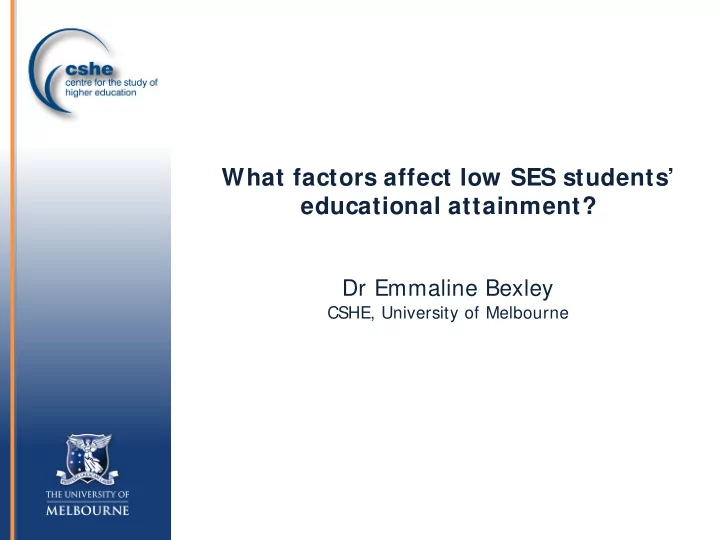

What factors affect low SES students’ educational attainment? Dr Emmaline Bexley CSHE, University of Melbourne
What do we mean by educational attainment? • High school completion rates • High school performance (ATAR etc) • Progression to university SES is closely correlated with performance on each of these measures.
So, what are the main factors affecting low SES students’ education attainment? 1.Different levels of resources available to the schools students from different SES groups typically attend.
The differing performance of students from the same ATAR band, but from different school types, once at university may be evidence of this: Monash University commencing students, 2000 to 2003: Average marks at the end of first year, by school type, and ENTER band. Illustration source: Dobson & Skuja 2005: 59
What factors affect low SES students’ education attainment? 1.Different levels of resources available to the schools students from different SES groups typically attend. 2.Differing personal incentives for academic achievement in senior high school according to social groupings.
Intentions regarding higher education of surveyed senior school students, by socioeconomic background (%) 2002 Source: James 2002
Cardak and Ryan (2006), using data from Longitudinal Surveys of Australian Youth (LSAY) cohorts, found that: • students from the same ENTER bands were equally likely to go to university regardless of socioeconomic and • ENTERs (and therefore university participation rates) were highest among students from high SES backgrounds who attended independent schools, and lowest among students from low SES backgrounds. But most importantly: High SES students who were achieving similar grades to low SES students in Year 9 went on to achieve ENTERs around 10 points higher three years later. So even strongly achieving Year 9 students from low SES backgrounds may be unable to translate their apparent potential into high ENTERs.
What factors affect low SES students’ education attainment? 1.Different levels of resources available to the schools students from different SES groups typically attend. 2.Differing personal incentives for academic achievement in senior high school according to social groupings. 3.Different post-school aspirations
Destinations of Year 12 completers, percentage of lowest and highest SES quintiles, 2006 Data source: Teese et al., 2007
What factors affect low SES students’ education attainment? 1.Different levels of resources available to the schools students from different SES groups typically attend. 2.Differing personal incentives for academic achievement in senior high school according to social groupings. 3.Different post-school aspirations 4.Alternative aspirations and attitudes to university, stemming from parental, family and school norms; encouraging and discouraging factors.
Selected factors relevant to post-school options by socioeconomic background (% agree) 58.2 Data source: James 2002
Availability and quality of education resources, aspirations and intentions, and the values of family, friends and teachers interact is ways that make obtaining grades sufficient to enter university via ATAR far less likely.
Enrolment in university by general achievement band Therefore, ATAR is and social profile of each achievement band tightly correlated with social class. The problem here, however, is not the ENTER but a school system that creates uneven outcomes across social class. Illustration source: Teese 2007: 53
Tertiary selection processes in themselves can do nothing to alter the problem of social inequalities, but ideally they should ameliorate rather than exacerbate their effects.
www.cshe.unimelb.edu.au bexleye@unimelb.edu.au
Recommend
More recommend